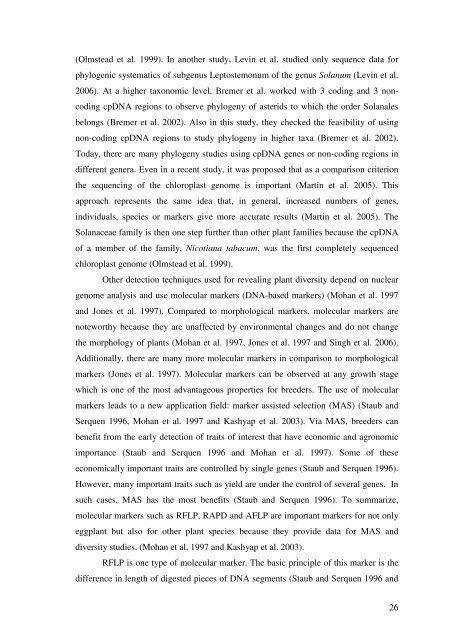determination of genetic diversity between eggplant and its wild ...
determination of genetic diversity between eggplant and its wild ...
determination of genetic diversity between eggplant and its wild ...
Create successful ePaper yourself
Turn your PDF publications into a flip-book with our unique Google optimized e-Paper software.
(Olmstead et al. 1999). In another study, Levin et al. studied only sequence data for<br />
phylogenic systematics <strong>of</strong> subgenus Leptostemonum <strong>of</strong> the genus Solanum (Levin et al.<br />
2006). At a higher taxonomic level, Bremer et al. worked with 3 coding <strong>and</strong> 3 non-<br />
coding cpDNA regions to observe phylogeny <strong>of</strong> asterids to which the order Solanales<br />
belongs (Bremer et al. 2002). Also in this study, they checked the feasibility <strong>of</strong> using<br />
non-coding cpDNA regions to study phylogeny in higher taxa (Bremer et al. 2002).<br />
Today, there are many phylogeny studies using cpDNA genes or non-coding regions in<br />
different genera. Even in a recent study, it was proposed that as a comparison criterion<br />
the sequencing <strong>of</strong> the chloroplast genome is important (Martin et al. 2005). This<br />
approach represents the same idea that, in general, increased numbers <strong>of</strong> genes,<br />
individuals, species or markers give more accurate results (Martin et al. 2005). The<br />
Solanaceae family is then one step further than other plant families because the cpDNA<br />
<strong>of</strong> a member <strong>of</strong> the family, Nicotiana tabacum, was the first completely sequenced<br />
chloroplast genome (Olmstead et al. 1999).<br />
Other detection techniques used for revealing plant <strong>diversity</strong> depend on nuclear<br />
genome analysis <strong>and</strong> use molecular markers (DNA-based markers) (Mohan et al. 1997<br />
<strong>and</strong> Jones et al. 1997). Compared to morphological markers, molecular markers are<br />
noteworthy because they are unaffected by environmental changes <strong>and</strong> do not change<br />
the morphology <strong>of</strong> plants (Mohan et al. 1997, Jones et al. 1997 <strong>and</strong> Singh et al. 2006).<br />
Additionally, there are many more molecular markers in comparison to morphological<br />
markers (Jones et al. 1997). Molecular markers can be observed at any growth stage<br />
which is one <strong>of</strong> the most advantageous properties for breeders. The use <strong>of</strong> molecular<br />
markers leads to a new application field: marker assisted selection (MAS) (Staub <strong>and</strong><br />
Serquen 1996, Mohan et al. 1997 <strong>and</strong> Kashyap et al. 2003). Via MAS, breeders can<br />
benefit from the early detection <strong>of</strong> tra<strong>its</strong> <strong>of</strong> interest that have economic <strong>and</strong> agronomic<br />
importance (Staub <strong>and</strong> Serquen 1996 <strong>and</strong> Mohan et al. 1997). Some <strong>of</strong> these<br />
economically important tra<strong>its</strong> are controlled by single genes (Staub <strong>and</strong> Serquen 1996).<br />
However, many important tra<strong>its</strong> such as yield are under the control <strong>of</strong> several genes. In<br />
such cases, MAS has the most benef<strong>its</strong> (Staub <strong>and</strong> Serquen 1996). To summarize,<br />
molecular markers such as RFLP, RAPD <strong>and</strong> AFLP are important markers for not only<br />
<strong>eggplant</strong> but also for other plant species because they provide data for MAS <strong>and</strong><br />
<strong>diversity</strong> studies. (Mohan et al. 1997 <strong>and</strong> Kashyap et al. 2003).<br />
RFLP is one type <strong>of</strong> molecular marker. The basic principle <strong>of</strong> this marker is the<br />
difference in length <strong>of</strong> digested pieces <strong>of</strong> DNA segments (Staub <strong>and</strong> Serquen 1996 <strong>and</strong><br />
26

















